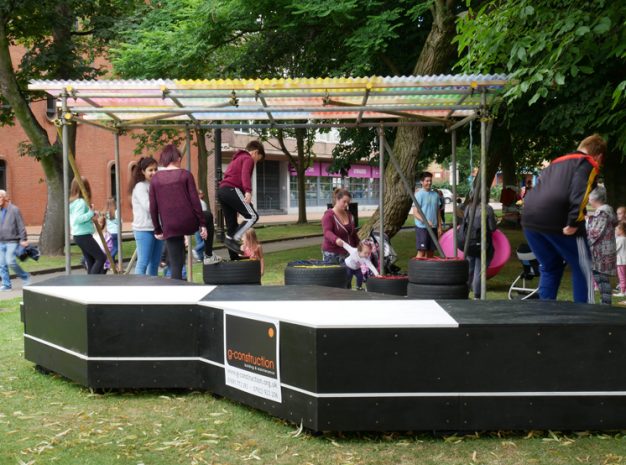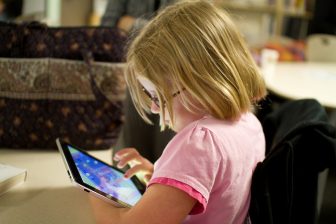
Co-creating space to support young people’s rights
A practice-led research project to include young people in the creation of a public space in Wrexham town centre, North Wales, demonstrates their capacity to participate in the design process and to provide ideas to inform town planning.
Research undertaken in Wrexham, North Wales, in response to the Welsh Government’s Play Sufficiency Duty, identified a generalised intolerance towards teenagers, their activities, and a lack of age-appropriate provision for them (Barclay and Tawil, 2013). This is not uncommon, as young people’s everyday activities are often described as ‘anti-social’. Additionally, a consumer culture can often disenfranchise those without capital, resulting in them being designed out of space. This can lead to a sense of alienation and placeless-ness, inhibiting their identity formation and socialisation (Edwards, 2015).
Promoted not constrained
To raise awareness of these issues a collaborative, practice-led research project was undertaken (including young people, artists, playworkers, youth workers, a building contractor and researcher). Using the United Nations Convention on the Rights of the Child and the additional General Comment 17 (2013) as a framework, it sought to: establish young people’s needs in the town centre; create a space where young people’s actions were promoted and not constrained – a space where play and spending time was advocated; and highlight young people’s need for equitable use of space.
The project also aimed to empower young people who were not engaged in formal participation systems; to illustrate their capacity to contribute ideas and convey their local knowledge; and to promote their inclusion in formal town planning processes as well as observe the project’s impact on the wider community.
Nineteen young people, aged 16-23, who were known to spend time in the town centre, participated in a series of workshops and evaluation sessions. Psychological and social issues were a consistent focus of the group’s discussions. For example, they spoke of their need to be in a group otherwise they would be intimidated by other young people, and of their fears that any installation would be vandalised.
Town centre lacking in ‘life’
They suggested that the town centre offered them little, was lacking in ‘life’, and that perceived drug users dominated the spaces they wanted to spend time in. Yet the easily accessible town centre was a locus for the group’s activities, particularly during the week between 4-9pm.
The group selected a centrally located site, one that they felt could raise awareness of the project topic and offered them some degree of privacy and sense of safety. In response to their design needs, the installation resulted in a raised platform with different levels to afford seating, bold design features and a roof. Tyres, adapted with brightly coloured rope, provided additional, ‘flexible’ seating. Observations showed the use of scaffolding increased the affordances to play by providing opportunities to climb, swing and hang out (also see Edwards, 2015).

The artists named the installation ‘Platform for the Magical Recovery of Community’ (‘The Platform’), due to the strong sense of community evidenced among the group of young participants. Although young people’s and the wider community’s affordances were increased, the group felt that their actions and ability to spend time on ‘The Platform’ remained constrained owing to the presence of perceived drug users.
Basic needs
The group’s initial needs were quite basic – shelter, access to toilets, somewhere to sit and to spend time with friends. As the project evolved they suggested ways to make the town centre more lively to attract more people, including requests for performance space that locals could use, free Wi-Fi, and more events. During the observations held in mid-summer there was a distinct lack of people at the square after 6 pm, after commercial activities ceased.
The temporary nature of the project appealed to the group, and they were keen for ‘The Platform’ to be re-used. They suggested that other young people should be given the opportunity to participate in similar projects, and proposed that the final designs should be placed at various locations around the town.
Participation levels were highest during site selection and when the sessions took place at the youth centre, a place regularly attended by the group. Attempts to involve the group at other locations to paint the structure with the artists, and construct ‘The Platform’ with the builders were unsuccessful. The group cited other commitments, yet they were known to be close by. An inferred view is that there was a reticence to act independently of the group and perhaps with contractors that were unfamiliar to them.
What did we learn?
The outcome of this project suggest that facilitating informal discussions among all of the project participants, as a means to build trust and, potentially, levels of confidence, may increase levels of participation. The adopted collaborative participatory approach was an effective method to draw data to inform planning and share professional knowledge. The artists, Simon and Tom Bloor felt they had gained an understanding of the social issues surrounding the project – more so than on previous projects – and also that, by working with the young people, they were better able to appreciate their needs.
The project also showed that adapting the public space to increase levels of activity, especially during the evening may increase a sense of safety and in turn young people’s affordances for hanging out and playing. The research showed that the participants readily took ownership of the structure. They expressed how much they liked it, suggesting that it looked modern and cool, and its potential to appeal to other young people. They were keen to participate in future projects, but had a preference for these to take place at the youth centre, or at other locations with a youth worker in attendance, or at least adults who they knew and trusted.
Despite assumptions, the tyres were not stolen and ‘The Platform’ wasn’t vandalised. This suggests that developing projects, where the intent is made known (an explanatory poster was placed at the site), and that include local participation may increase levels of ownership and consideration towards the final solution.
Claire Edwards
Photos: Claire Edwards
References
Barclay, M. and Tawil, B. (2013) Wrexham Play Sufficiency Assessment, Glyndwr University and Wrexham County Borough Council.
Edwards, C. (2015) A Critical Discussion of the Provision of Public Space for Young People in the UK. Leeds Beckett University.
Edwards, C. (2017) Co-creating a temporary space to support the rights of young people, Oriel Wrecsam, Wrexham Council, the Arts Council of Wales.
Claire Edwards was responsible for the project research, and the initial project concept. However, the project wouldn’t have come to fruition without the working partnerships with Mike Barclay and Steffan Jones-Hughes and the contribution of many others. Project funding was awarded to Oriel Wrecsam by the Arts Council of Wales. Oriel Wrecsam’s remit includes increasing social engagement in the arts.




